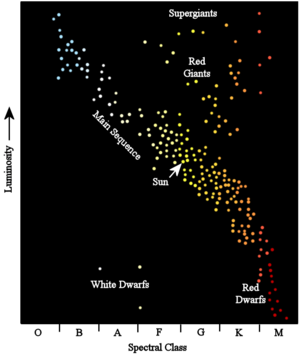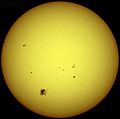Main sequence facts for kids
The main sequence is a special area on a Hertzsprung–Russell diagram. Most stars, including our own Sun, are found in this area. If a star is in this region, it's called a main-sequence star. Most stars in the Milky Way galaxy and other galaxies are main-sequence stars. This is because stars in this phase are very stable, so they stay here for a very long time.
A Hertzsprung-Russell diagram is a graph that shows how bright a star is compared to its temperature or color. The main sequence looks like a diagonal band. It goes from the top-left (where stars are hot and bright) to the bottom-right (where stars are cooler and less bright). You can see an example of this band of main-sequence stars in the picture on the right.
Contents
How Stars Live on the Main Sequence
Stars are born from huge clouds of gas and dust called nebula. When a new star forms, it first appears on the main sequence. Stars spend millions or even billions of years in this stage of their lives.
While on the main sequence, stars create energy by a process called nuclear fusion. This is like a giant natural power plant inside the star. They turn hydrogen into helium in their core. This process releases a lot of light and heat.
When a star starts to run out of hydrogen fuel, it changes. It gets much bigger and cooler, turning into a red giant. Once this happens, the star is no longer on the main sequence. It doesn't stay a red giant for as long as it was a main-sequence star.
Different Kinds of Main-Sequence Stars
Stars on the main sequence are not all the same. The hottest and brightest stars are usually the biggest. These are found in the upper-left part of the Hertzsprung-Russell diagram.
Scientists sometimes divide the main sequence into two parts:
- Upper main sequence: These stars are more than 1.5 times the mass of our Sun. They are hotter and brighter.
- Lower main sequence: These stars are less than 1.5 times the mass of our Sun. They are cooler and less bright.
Stars in the upper main sequence create energy using a simple type of nuclear fusion that only involves hydrogen and helium. Stars in the lower main sequence use a different type of fusion. This type uses other elements like carbon, nitrogen, and oxygen as helpers, or catalysts, to make the fusion happen.
How Long Do Main-Sequence Stars Live?
Because of these different ways of making energy, stars on the lower main sequence live much longer than stars on the upper main sequence.
Our Sun is a lower main-sequence star. Scientists predict it will shine for about 10 to 12 billion years. A very big star on the upper main sequence might only last a few million years. This is because bigger stars burn through their fuel much faster.
How Do Astronomers Use the Main Sequence?
Today, astronomers can often tell if a new star is on the main sequence just by looking at its color. For a main-sequence star of a certain color, its brightness is usually within a small range when seen from a standard distance.
This is very helpful! An astronomer can compare how bright a newly found star looks from Earth to how bright a main-sequence star of that color should be. This helps them figure out how far away the new star is.
Images for kids
-
A Hertzsprung–Russell diagram shows a star's brightness against its color. The main sequence is the diagonal band.
-
The Sun is the most familiar example of a main-sequence star.
See also
 In Spanish: Secuencia principal para niños
In Spanish: Secuencia principal para niños






